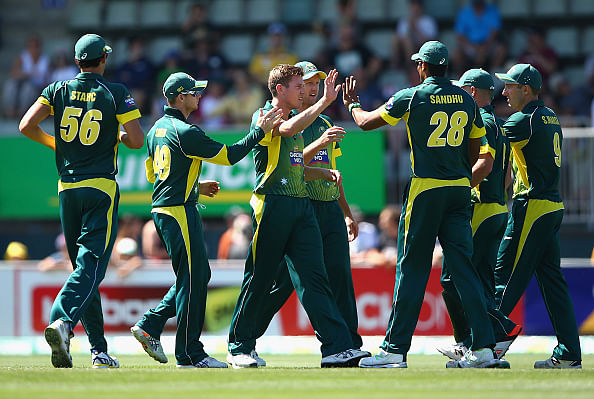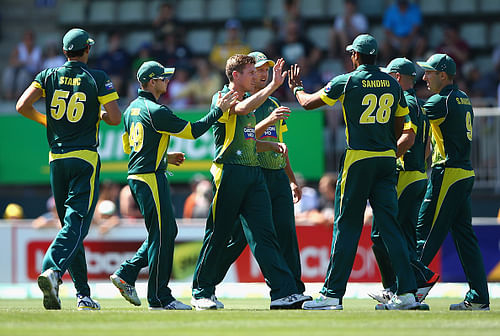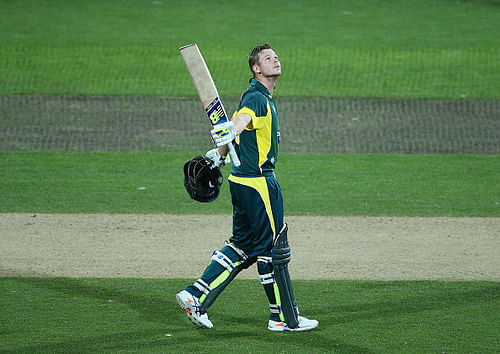
World Cup Predictions: Can Australia live up to expectations and win their 5th World Cup?

The last time Oceania played host to cricket’s mega event, Australia cut a sorry figure in front of home crowds – failing to reach the top four. They were defending champions back then and responded to the minor blip fiercely in subsequent editions. Australia came 2nd in 1996 and pulled off a hat-trick of wins between 1999 and 2007, before stumbling in 2011.
This time around, as the World Cup returns to familiar territory, they have everything going in their favour. The raucous fans will be cheering for them, the pitches will be offering pace and bounce, there’ll be little turn, and the ball will be come on to the bat perfectly. To top all of that, there won’t be the additional baggage of being defending champions.
But to say that there won’t be any pressure will be pushing it. There’ll be expecations of an iminent Aussie win, everywhere in the country. The biggest talking point will be whether Australia are able to withstand themselves from crumbling under these expectations.
Let’s try and figure out how Australia fare as contenders for the ICC World Cup 2015, and decipher their fate in the process.
Best and worst case scenarios
The nature of the format is such that only under extraordinary circumstances will a top team fail to make it to the final eight. In the absence of potential forfeitures by Australia and surprise heists by minnows, Michael Clarke’s boys are sure of a quarter-final berth. The knock-out policy of the tournament then kicks in and gives Australia a home game at Adelaide as quarters. Being the stronger looking team in its group, pool topping Australia are expected to book themselves a contest with the West Indies, who on current form are expected to be the last team to qualify from Pool B.
Australia’s main challenge for the top slot in Pool A will come in the form of co-hosts New Zealand, who look terrific these days. Even if such a scenario is to arise, Australia will still hold on to the right of playing in front of their home crowd. However, instead of the mediocre West Indies, they will face a more formidable Pakistan at Adelaide.
It is reasonable to assume that South Africa will dominate Pool B, with India and Pakistan contesting for the 2nd and the 3rd spot. The Men in Blue’s superior record against their neighbours in World Cups, has made me put India at 2nd and Pakistan at 3rd in their pool. All in all, a realistic scenario will ensure either an Australia against West Indies quarter-final or an Australia against Pakistan quarter-final, both of which seem to be relatively easy hurdles to cross.
The situation gets a little tricky when the final four are drawn, since as per schedule, New Zealand and Australia get to play their respective semi-finals at home, unless they are pitted against each other, in which case the team that is higher in Pool A will get the privilege of playing at home. Assuming the non occurrence of this scenario, Australia will enjoy a home advantage even in the semi-finals, giving them a fabulous chance of making it to the finals after eight years. What will happen in the finals is hard to predict, but an Australian team reaching there seems to have a bright prospect currently.
Australia are a team with all bases covered, something that will hold them in good stead come the latter stages of the World Cup. They have a terrific top-order in the form of David Warner and Aaron Finch; the middle-order has the fire power of Steven Smith and Glenn Maxwell, and the calm of George Bailey. Lower down the order, they have the brute of Mitchell Marsh and James Faulkner, both of whom can do the job in the end overs of an One-Day International (ODI) innings with remarkable aplomb.
The two Mitchells, Johnson and Starc, will lead the Australian attack with the ball. This appears to be a team with very little weakness. The worst case scenario of Australia losing all their matches against formidable opposition and finishing 4th in Pool A seems improbable currently. But even if that does happen, one can trust Australia to negate the threat of South Africa or India in the quarter-finals at Adelaide.
| Best Case | Champions |
|---|---|
| Worst Case | Quarter-finalists (losing to India/South Africa) |
| Most Likely | Finalists |
Players to watch out for
Even as we speak, the chances of seeing Michael Clarke lead the team in the World Cup appear bleak. Reportedly, a large part of the Australian contingent want Steve Smith to lead, making it imperative for some players to stand up and try to fill the leadership vacuum with inspiring performances.
For a team that has faltered at home before, it is important to identify match winners who will win them more than just the occasional match for the team. While the potency of the unit as a whole need not be questioned, some names do stand out – including that of the Test captain, Smith, and stand-in ODI skipper, Bailey. Here are three players to watch out for from Australia:
Steven Smith: The latest recipient of the Alan Border Medal for being Australia’s Cricketer of the Year, Smith currently is the man with the Midas touch. With his ODI century in Hobart last week, he became the only person to make a hundred on captaincy debut in both formats of the game.

His performances have been phenomenal, his strategies – raw but incisive. Four hundreds and three half-centuries in the last nine Test innings and three ODI hundreds and three fifties in the same period. These numbers are of a batsman who was written off quite early in his career. They are of a batsman who plays as unconventionally as anyone could but ends up scoring tons and tons of runs. Not once this summer has Smith looked vulnerable to any bowling attack. If his red hot form continues, there’s misery in store for a number of bowlers around the world.
George Bailey: Australia’s stand-in ODI captain has had an abysmal last 12 months in one-dayers after his great showing in 2013. With just three half-centuries since Australia Day last year, Bailey averaged 25.40 against South Africa and 15.33 against Pakistan. In the first two games of the ongoing tri-series, Bailey has a cumulative of 15 against his name. His place in the XI seems to be in doubt right now, making him a rather contentious pick as a player to watch out for. However, if history is anything to go by, those who have been under the pump have performed the best.
While everyone around Bailey can fall prey to complacency and over-confidence, the 32-year-old Tasmanian will have a lot to prove – especially since he continues to be Australia’s captain for the time being. If one goes through Australia’s World Cup fifteen, Bailey is the one with the maximum incentive to perform. And considering his calming presence in a gung-ho batting line-up and vast experience, Bailey is definitely a player to watch out for.
Mitchell Starc: For a player who was dropped from the Australian Test line-up recently, Starc has done enough for people to stand up and take notice of his performances. Maybe it was the new found aggression. Maybe it was the well deserved break. But Starc is surely shaping up to be the star of Australia’s 2015 World Cup campaign.
Starc’s 17 wickets in ODIs this summer have come at a shade under seventeen a piece. He gives away 20.62 runs for every wicket that he picks up and has a wicket to his name every 25 deliveries. With a better strike-rate (despite the smaller sample size) than Dale Steyn, Malcolm Marshall and Wasim Akram, Starc shouldn’t be taken lightly by any team.
His death bowling skills will come in handy, considering his ability to swing the ball in to the right-hander while bowling round the wicket at yorker length. In addition to that, he has the handy knack of picking up early wickets and knocking the wind out of the opposition’s top-order, and we are potentially looking at the World Cup’s Man-of-the-Tournament.
Verdict
Australia look to be the favourites for the 2015 World Cup. But declaring them as champions right now would be slightly fallacious considering the unpredictability of knock-outs. So I would take the safe option of naming them as one of the finalists on current form. They have a strong team with serious reputation and talent. If injuries can be kept at bay and public pressure sustained, the trophy might just return to where it has spent a lot of its time since 1975.